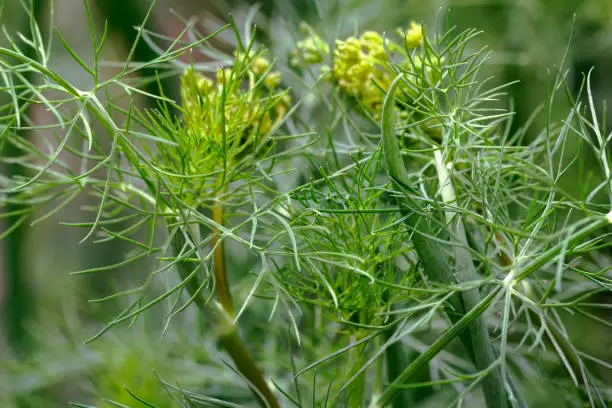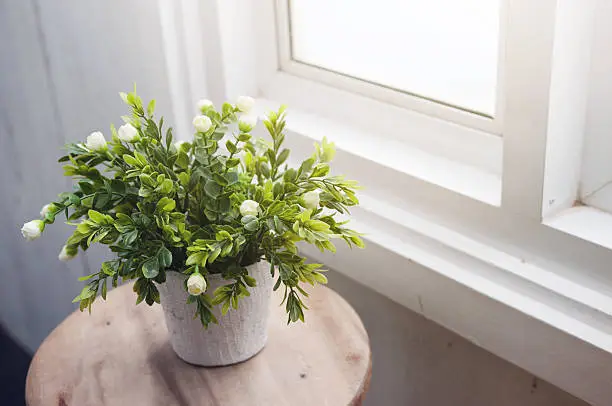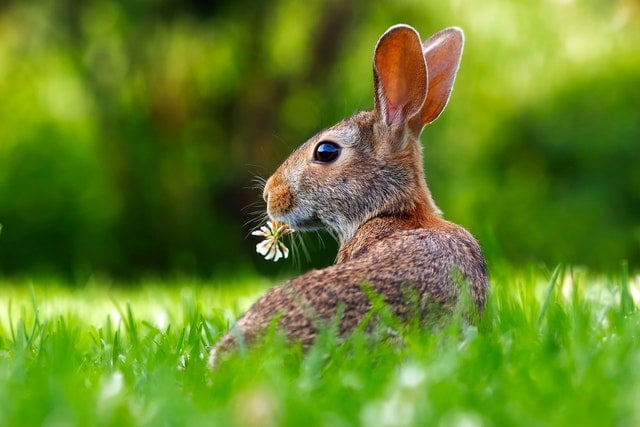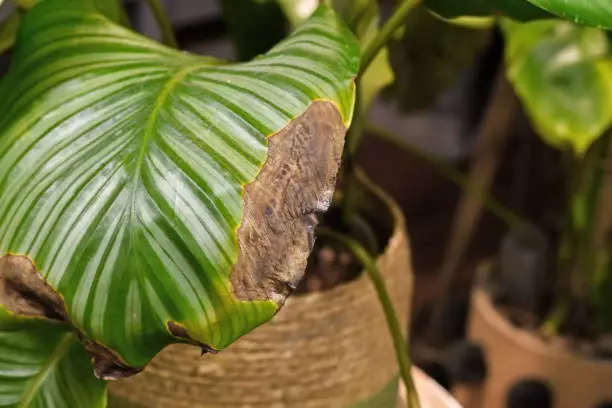Leaf curl in snake plants is a sign something is wrong and needs fixing quickly to save the plant. The problem can be anything from water problems to root disease, or something else. The good news is, that the plant can be saved with some care remedies.
Curling snake plant leaves are caused by underwatering, too much sunlight, pest infestation, or stress from transplanting the plant. Water your snake plant once every 2-4 weeks, treat pests, and maintain a temperature of 55-85°F to fix and revive the curling snake plant.
Why are snake plant’s leaves twisting?
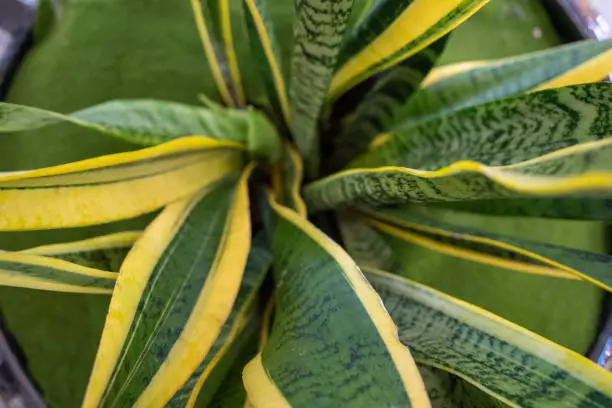
It’s essential to identify the specific reason why your snake plant leave is curling to ensure you offer the best solution. You have to look at symptoms to identify the root cause. Some of these causes are overwatering, underwatering, inappropriate temperatures, and fungal infestation.
Underwatering
Although drought-resistant, underwatering snake plants over a long time can have serious consequences. When your snake plant is underwatered, it will fail to perform normal physiological functions. Because of lack of moisture, sansevieria would fail to carry nutrients from the soil and transport it to other parts of the plant.
RELATED: HOW TO REVIVE UNDERWATERED SNAKE PLANT
When the leaves don’t get the essentials, including water, they will lose shape and start curling to preserve moisture. In severe cases, they may develop wrinkles.
Overwatering
Overwatering in snake plants can kill the plant if not remedied quickly. Yellowing and downward curling of leaves is a sign of an overwatered snake plant.
Because of too much water, the plant is likely to develop root rot, rendering the root system ineffective. Since the roots become dysfunctional, the plants wouldn’t supply nutrients and water to the leaves, making them curl or appear mushy and droopy.
Inadequate light
A Snake plant doesn’t require much light to thrive. However, when they don’t receive enough light, they might start showing signs of curled leaves. Plants need light to perform photosynthesis. Without it, the plant wouldn’t make its own food.
Inappropriate temperature
Extreme temperatures are bad for sansevieria plants. Snake plants require an optimal temperature of about 55-85°F. High temperatures usually accelerate the transpiration process. When the plant loses water more than the usual amount, its leaves would likely curl.
Low temperature forces the water within the leaves to freeze and form crystals, which leads to permanent damage to the leaves.
Too much fertilizer
Snake plants don’t require a lot of fertilizers and they can thrive without any. In summer or growth periods applying once every 1-2 months is enough. Excess fertilizers damage the roots and leaves of these plants.
When they can’t handle the additional nutrients any more, their leaves would curl inwards or appear burnt.
Fungal infestation
There are several types of fungi like southern blight and red leaf spot, which damage the roots and the leaves of the snake plants. A sign that your plant could be infested with a fungal disease is when they develop web-like growth or discolored spots in black, white, red, or brown.
Fungi spread quickly, and if your plant comes in contact with other infected plants, it’s likely to develop an infection.
Shock from transplanting
Transplanting and propagation are some of the main problems of snake plants. After repotting, it might take a while before the plant adjusts to its new environment and potting soil. Roots often suffer the most significant shock.
During this period, the snake plant may fail to absorb water, thus interfering with the functioning of the plant. Twisting leaves may be an indication a snake plant is suffering from the transplant shock, especially when you’ve repotted it recently.
Incorrect pH
The correct PH in a plant is essential as it determines the nutrients found in the soil. For a snake plant, the optimum range would be between 5.5 to 7.5. When the soil is acidic, or the pH is low, it will lack magnesium. Without magnesium, leaves wouldn’t be able to produce the chlorophyll necessary for photosynthesis.
The lower or older leaves are therefore likely to turn yellow or curl. Sometimes, pH problems can lead to brown spots on the leaves of sansevieria plants.
The pot is too small
Sansevieria needs large or well-fitting pots to thrive. You should change the size of the pot, depending on the age of your snake plant. As it continues to age, the roots also grow and become rootbound if the pot size isn’t changed.
Being root-bound may cause the plant’s leaves to curl since the root system doesn’t have enough space, limiting their functioning and nutrient intake.
Root rot
Excess or stagnant water accelerates fungal infections. Since the roots rots render the plant leaves dysfunctional, the roots fail to supply the required nutrients, resulting in curling leaves.
Insect infestation
Mealybugs, spider mites, and thrips love attacking the snake plant. Thrips are tiny black insects that are difficult to spot without using a magnifying glass. When they attack your plants, they leave rough, uneven patches on the leaves.
When Mealybugs and spider mites attack the snake plant, they are likely to suck the juices from the leaves, making them curl and shrink. When left untreated, pests can also make the leaves of your snake plant wrinkle up.
RELATED: HOW TO TREAT SNAKE PLANT FROM HAVING BROWN TIPS AND SPOTS
Types of leaf curl
Snake plants curve differently, depending on the cause of the curl. Here are some of the curls you might encounter:
- Leaf tips curling downwards: When the leaves curl at the tips or the margins, the plant is trying to retain the moisture. The major causes of leaves curling downwards are overwatering or overfeeding.
- Leaves tips curling upwards: The environment majorly causes leaves to curl upwards. Examples of these conditions are light being too close to the plant, temperature stress, extreme humidity levels, windburn, or limited air circulation.
- Leaf margin curl: When the leaf margin curls downwards, it indicates there could be a problem with the roots. Overfeeding the plant is the primary culprit. Other causes are inappropriate temperatures, low oxygen in the roots, and any other issues causing the leaf tips to curl downwards.
- Leaves curling inwards: Nitrogen deficiency causes leaves to curl inwards with the lower leaves being the most affected. Your snake plant will first turn yellow and soft, then curl inwards.
Solutions for curving leaves in sansevieria
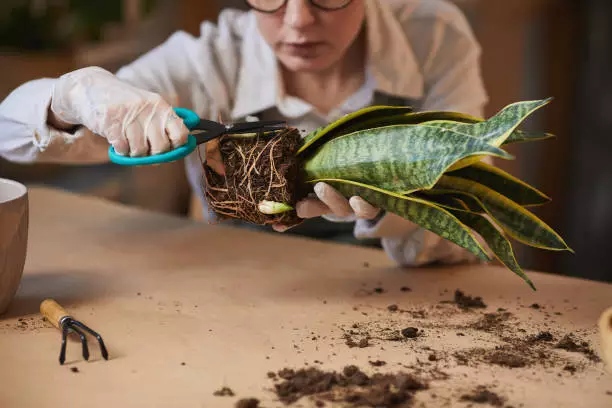
Once you know the cause of the curling leaves, you can make your snake plant healthy again with a few solutions.
Here’s how to stop leaf curl in sansevieria plants:
1. Water sansevieria once every 2-4 weeks
Underwatered plants don’t need much water to revive them. Watering once every 2-4 weeks is enough to fulfill its moisture needs. The watering frequency would depend on potting mix quality, season, and pot size.
When the soil is compact, unloosen it before you embark on watering it regularly. Within a few days of correct watering, the leaves will start unfurling.
If you suspect your plant leaves could be curling because of overwatering, check the root system. Take out the whole plant from the soil, and wash the roots to remove the soil. Inspect the roots if there’s a foul smell coming; it means it’s been affected by root rot.
Cut off the affected roots and disinfect the roots using charcoal powder or a dilute hydrogen peroxide solution. Next, repot the plant using a new potting mix recommended for snake plants – e.g. Rio Hamza Soil Mixture for Snake Plants. You can use a new pot or wash the old pot to prevent further contamination. If the roots are severely damaged, propagate them to save the plant from dying.
2. Provide bright indirect light
Sansevieria prefers bright indirect light. If you place it in the scorching sun, the snake plant’s leaves will turn brown and curl due to the increased rate of dehydration.
To fix the curling leaves, move the plant to a spot where it will receive bright indirect light. An east-facing window in your house will do great for it. Alternatively, you can use artificial LED grow lights light to meet the lighting requirements.
3. Use just enough fertilizer
For a continuous supply of nutrients, use a nitrogen-rich fertilizer. To avoid the risk of over-fertilizing, go for organic fertilizer as it’s slow-releasing. Always follow the instructions on the package to supply the plant with the recommended dose and prevent leaf curl that’s caused by the salt burn.
4. Maintain temperature at 55-85°F
If you reside in places where the temperatures are extremely high, always keep the plant in the shade or somewhere with a lower temperature. For areas where the temperatures are below 50 Fahrenheit, avoid leaving the plant outside.
Alternatively, when you decide to leave them outside, you can cover the plants with a blanket or transparent sheet. When you keep the plant indoors, ensure it remains warm. Always strive to keep your plant at room temperature. Sansevieria like temperatures between 55-85°F so tries to maintain that to keep the plant healthy.
5. Transplant with a new potting mix
After transplanting your snake plant, keep it in a partial shade and water sparingly. Give it a few days to adjust to the new environment. Don’t use old potting mix, as it may lack the nutrients needed to food the plant. Instead, go for nutrient-rich and well-draining soil to ensure the snake plant reaches its full potential.
RELATED: HOW LONG DOES IT LAST FOR POTTING SOIL TO BECOME BAD AND EXPIRE
6. Amend the soil pH to 5.5 to 7.5
Sansevieria prefers a soil pH range of 5.5 to 7.5. Curling leaves could be a sign the pH needs to be corrected to allow the plant to draw nutrients effectively. To be sure the problem is the pH of the soil use a probing soil pH tester to check whether the soil is good for your plant.
For low pH, you will need to increase the pH by adding hydrated lime to the soil. For higher pH, add lemon juice to the water before watering to help in decreasing the pH level.
7. Get rid of pests
Pests are easy to eliminate from a snake plant. But first, ensure you keep the infested plant away from other plants to avoid spreading. Next, remove the leaves that depict any sign of infection. Use an alcohol-soaked cloth to wipe the leaves of the plant.
Additionally, you can use neem oil by applying to ensure the pests don’t ever come again. Apply neem oil once a week. Snake plants leave curling shouldn’t worry you. With the proper measures, your plant would be healthy once again.
